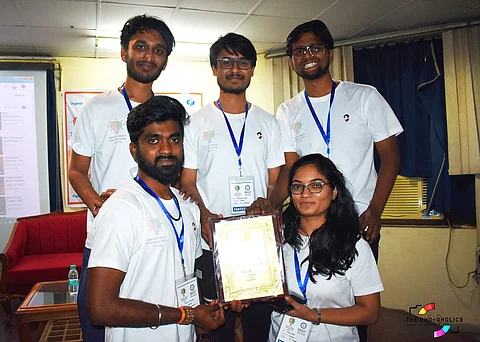

And they're back again for another year. Smart India Hackathon is a unique Open Innovation Model started to identify new and disruptive technology innovations to solve the challenges faced in the country. It's a non-stop product development competition where problem statements are posed to technology students for innovative solutions. The competition this year was held at Ghaziabad, UP on March 2 and 3, 2019 by the Ministry of Human Resources Development, Govt of India.
The team from Indian Institute of Technology Hyderabad won the Smart India Hackathon 2019 for coming up with a solution to a problem on steel construction. Called SNAAPP, the team consists of six MTech students — Siddharth Gupta (2nd year), Prabhat Kumar Rai (2nd year), Nisha Akole (1st year), Ajay Hase (1st year), Prasad Gaikwad (1st year) and Aman Agarwal (1st year) — pursuing their master's in communication and signal processing.
The problem statement given to the IIT-H students was to develop an app that can manage the hierarchical system of updating construction site progress and generate reports directly for managers and higher authorities. "We planned our model first and came up with a blueprint of our solution. We first understood the problem statement completely and what the demand was for the problem. Then, we prepared the client and user side application and successfully demonstrated it in successive rounds. We made enhancements in our proposed solution on the spot based on feedback provided by the judges," says Siddharth, the team lead.
The team did non-stop coding for 36 hours and delivered the mobile app as part of their proposed solution. Speaking about those gruelling 36 hours, Siddharth says, "It was pretty difficult because of the pressure and competitive environment at the venue. We had to give four rounds of presentations and demos to become the winners." The application is structured in two parts — the Manager's Dashboard and Site Engineer's Dashboard. Site engineers from different areas will provide details in the form of text and images. Timestamp and GPS location will be taken automatically.
Once the report is submitted from the Site Engineer's app, it will reflect on the Manager's Dashboard and the progress can be checked on a real-time basis. Aside from this, the site engineer can ask for materials, machine or workforce requirements, if needed. The algorithm is written to help in generating reports on a daily and weekly basis. The objective of the app is to be aware of the construction progress and maintain reports in real time so as to improve work efficiency. As the app sends updates directly from the authorities who are working on the field, this will reduce the time gap between site engineers and managers. It will also help in optimising the cost incurred.
As for future plans, the team wants to provide more features like voice assistant and auto-assignment of tasks. "In terms of business model, we would like to collaborate with other infrastructure companies and provide them with the proposed solution. This is not just a device but software as well which will be helpful for companies constructing pre-engineered buildings," concludes Siddharth.
